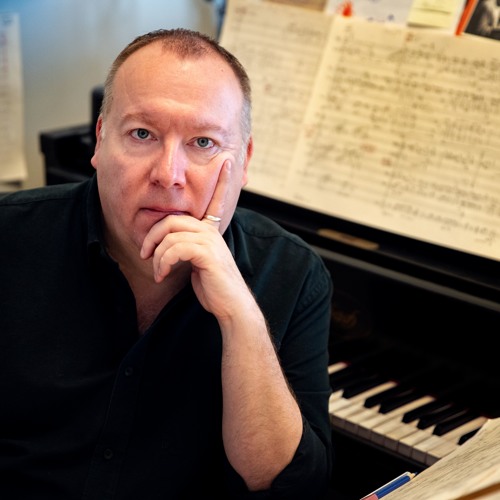by Jarrett Hoffman

First there is the guest composer: Christopher Cerrone, who in the last decade has been both a finalist for the Pulitzer Prize and the winner of the Rome Prize.
Second is the program’s dedicatee: Kaija Saariaho, who was considered one of the greatest living composers until her passing in June from brain cancer.
I reached the Ensemble’s director, Keith Fitch (pictured), to learn about how that idea came together, and how Cerrone and Saariaho mesh.
Fitch was serving as guest composer himself at the 2019 Mostly Modern Festival in Saratoga Springs, NY when he first met Cerrone. “He happened to be in town and came to a concert,” Fitch said on Zoom, noting that he added Cerrone to his list of composers he’d like to invite to campus. “We’re lucky to get him because his career is really quite busy right now.”
Describing Cerrone’s writing, Fitch first pointed out that contemporary music can sometimes get a little weighty. “And it should — we’re all different types of composers. But Chris’s music has a certain lightness to it which I find really attractive.”
With Saariaho’s passing in June, Fitch got to thinking about what he could do to honor her. “She was such an important international figure that I thought, I really need to do something.” He reached out to Cerrone, asking whether he would mind if this concert, featuring him as guest composer, were also dedicated to Saariaho. “He had no problem with that at all. And I thought that their music would be an interesting pairing.”
Fitch explained that both composers deal extensively in color and texture, but in different ways. “One of Chris’s pieces that we’re doing has prepared piano and tuned flower pots. So he’s using either found or slightly altered sound sources. Whereas Saariaho, because of her long experience with electronic music and her time at IRCAM” — the Institute for Research and Coordination in Acoustics/Music — “tried to reproduce electronic sounds on acoustic instruments. So you have a lot of ponticello, harmonics, different types of bow pressure — different approaches to the instrument to fall somewhere in between acoustic and electronic sound.”
Indeed, many people know Saariaho for her electronic music, as well as her operas and orchestral music. “But I wanted to show another side of her and expose the students to two of her purely acoustic chamber pieces,” Fitch said.
The program opens with Cerrone’s Invisible Overture — the overture to his opera Invisible Cities but here appearing in its chamber version for ten players. “Then I wanted to balance that with the smaller of the Saariaho pieces — the Sept Papillons for solo cello.” That will be followed by Cerrone’s Nervous Systems for clarinet and string quartet. “I thought that would be a great end to the first half.”
Next is Saariaho’s Serenatas for piano, cello, and percussion — not only an excellent second-half opener, Fitch said, but also strategically placed after intermission to leave time for preparing the large setup of percussion instruments. “Then we’re ending with a Pierrot-plus sextet of Chris’s — Why Was I Born Between Mirrors? — which is the piece with the prepared piano and the flower pots. It’s very colorful, and it’s going to be a nice, fun ender.”
I mentioned to Fitch that whenever I research a program before an interview, I tend to wonder about the ideas behind it, but forget to think about the more basic element of getting from one thing to the next, like with Saariaho’s Serenatas and its percussion setup.
“There are often these practical concerns, particularly with a new music concert, where you might have a lot of percussion in different setups, and/or electronics,” he said. “You really have to take into account all these different moving parts and try to find a balance between what works logistically and what works musically. Usually we find the right solution that makes it practical for everybody — the musicians, the setup crew, the audience. I don’t want people sitting there for ten minutes in silence while we set up the percussion.”
In closing, I asked Fitch about his reaction to finding out that Saariaho had passed. “I got a text from a couple of friends,” he said. “I knew she was quite ill. She had the same type of brain cancer that Steve Stuckey had, which moves very, very quickly. And she was only 70, which these days is really young for someone to pass. It leaves a big gap on the international stage. I didn’t know her, but everyone who knew her was just enamored of her.”
The concert is free, reservations required. It will also be livestreamed. And on Saturday, November 11 at 4:00 pm in Room 217 at CIM, Cerrone will discuss his music in a free symposium.
Published on ClevelandClassical.com November 9, 2023.
Click here for a printable copy of this article


